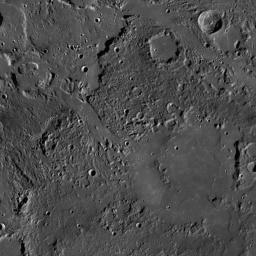This image is a portion of the MDIS global mosaic basemap that was acquired during MESSENGER's first year in orbit. Of particular note is the flat-floored, southeast-trending valley in the center of the image, which starts near several depressions to the top left of the image, and connects with the Kofi crater (center right).
This valley is interpreted by MESSENGER team scientists as a broad lava channel, formed by the mechanical and thermal erosion of Mercury's surface by hot, low-viscosity, quickly-flowing lavas. The pits to the top left may be source vents for the lava flows that formed the channel; these flows then filled the Kofi crater at the channel's other end. Another lava channel, with a similar southeast trend, lies at the top right of the image, and there is a total of five broad channels in this region.
Determining how these channels formed, how rapidly they shaped the landscape, and how they relate to other volcanic features on Mercury -- such as expansive smooth plains nearby -- is important in understanding the role of volcanism on Mercury. Moreover, similar broad channels do not appear to exist elsewhere on Mercury, making this region a particularly interesting locale.
Date Created: February 10, 2012
Instrument: Mercury Dual Imaging System (MDIS)
Latitude Rang: 54.3° N to 61.3° N
Longitude Range: 109.4° E to 121.6° E
Resolution: 146 meters/pixel
Scale: Kofi, the large impact crater at center right, is approximately 135 km (84 mi.) in diameter
Projection: Azimuthal equidistant
The MESSENGER spacecraft is the first ever to orbit the planet Mercury, and the spacecraft's seven scientific instruments and radio science investigation are unraveling the history and evolution of the Solar System's innermost planet. Visit the Why Mercury? section of this website to learn more about the key science questions that the MESSENGER mission is addressing. During the one-year primary mission, MDIS acquired 88,746 images and extensive other data sets. MESSENGER is now in a year-long extended mission, during which plans call for the acquisition of more than 80,000 additional images to support MESSENGER's science goals.
These images are from MESSENGER, a NASA Discovery mission to conduct the first orbital study of the innermost planet, Mercury. For information regarding the use of images, see the MESSENGER image use policy.

 Planetary Data System
Planetary Data System












